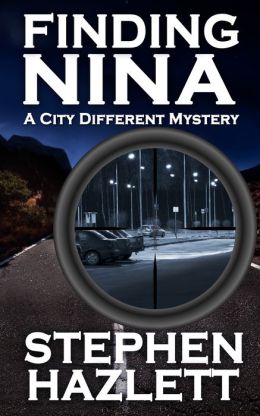Another win from the LibraryThing giveaway program, which I highly recommend if you ever find yourself short of books to review ; ) .
Finding Nina is the concluding volume to Stephen Hazlett’s City Different trilogy (“The City Different,” an in-story Jeopardy question informs me, is a nickname for Santa Fe). It’s been described variously as a mystery, a thriller, and an “edgy romance”. It’s more a thriller than either of the others–a high-stakes, twisted story of rivalry and obsession, as small-time criminal Sammy Garza and ex-cop Ray Sanchez, meeting in prison, discover they both know Nina Kelly. Beautiful, clever, but a bit lost, Nina’s drifting through a crumbling marriage, just in time to find herself caught in this bizarre love triangle. There isn’t really any mystery going on here–we as readers know who’s behind everything, even if the characters don’t–and while there may be some sick version of a love story here, it does not follow the conventions of a romance. Shakespearean comedy concluding with a marriage this one ain’t.
This isn’t a bad thing. This story isn’t meant to be fluffy or even particularity happy. What it is supposed to do is provide suspense and thrills–the literary equivalent of a roller coaster ride. At times it achieves this, but at times less so.
The main problem with this story, and the reason it’s taken me over a month to get around to finishing and reviewing it, is that for a thriller the pacing is very, very slow. It takes almost a hundred pages for the plot to really get going–at first it’s just Garza and Sanchez doing a lot of macho posturing at each other, and Nina sort of drifting through with her failing marriage. On a sentence and paragraph level, there’s a lot of showing where telling might be quicker and easier. There’s such a thing as too much detail. And pleonasms about. There’s a line about Nina eating by “spooning yogurt from a container into her mouth.”
Dialogue is weakened when padded by “maybes” and reliance on adverbs and vagaries. There is also too much framing language–once a scene is established from Ray’s POV, I don’t need to be told “Ray was thinking.” It made paragraphs unnecessarily long, especially considering this ebook is meant to read onscreen.
Here’s an example paragraph to illustrate what I mean:
Ray was thinking that if it had been reported stolen, then Santa Fe police would have a record of it.
Harris could have checked for that, but he apparently hadn’t. Maybe he was slipping. But Ray didn’t say any of that, simply saying,”And?”
This could have be trimmed to:
If it had been reported stolen, the Santa Fe police would have a record. Apparently Harris hadn’t checked for that, although he could have. He was slipping. But Ray let it go. “And?”
Small difference, maybe, but I think a noticeable one over the scale of an entire novel.
Even once the plot gets going, we’re slowly walked through the practical minutiae of a kidnapping. At this point, actually, I was interested. The fun of reading crime novels is getting into the head of a criminal and seeing how he does it. In this particular case, our boy Sammy and our girl Nina have a time of things negotiating everything from peeing while blindfolded (perhaps too much detail here) to squabbling over who gets to eat the Hungry Man and who gets the Lean Cuisine, a scene that was so unexpectedly amusing and cute that I forgave the scene of Sammy going grocery shopping. The banality is the point of it. Seeing these small details did help me understand, to some extent, how Garza and Nina got used to each other and how Garza, at least, comes to fall for her. All the same it seemed like one-sided affection to me, while Nina and Ray’s relationship seemed built mostly of backstory from the previous 2 novels.
One last note on the level of detail–when you watch a criminal plot his crimes, complete with all the second-guessing, reconsidering, and questioning his sources of information, you become more sympathetic to him but also much less intimidated. When Garza describes his crimes in the first pages, I couldn’t help thinking that ringing the doorbell to check that nobody’s home before burglarizing the house seems rather 101 level criminology. Watching him debate whether he needs a taser for his kidnapping or just a stun gun, basing his information on TV shows, is like watching a kid playing dress-up. I found his awkwardness almost endearing and so the way he softened around Nina made sense–he didn’t seem a bad guy at heart. Then he suddenly takes a turn for the truly dark at the end that surprised me. To be clear, I’m skeptical of any guy who tries to get into a woman’s heart while keeping her prisoner, but I wasn’t sure the story’s logic agreed with me. Garza may well have been a nice guy who made mistakes.
Anyway, that sudden dark turn led to a twist ending which, depending on your feelings for the characters and your expectations, will be either poignant or make this a Shaggy Dog story. Which it is, is up to you, although I’m curious about the reactions of readers who have stuck with these characters for three books.


 Therese Arkenberg's first short story was accepted for publication on January 2, 2008, and her second acceptance came a few hours later. Since then they haven't always been in such a rush, yet her work appears in places like Beneath Ceaseless Skies, Analog, Daily Science Fiction, and the anthology Sword & Sorceress XXIV. Aqua Vitae, her science fiction novella, was released by WolfSinger Publications in December 2011.
She works as a freelance editor and writer in Wisconsin, where she returned after a brief but unforgettable time in Washington, D.C. When she isn't reading, writing, or editing (it's true!) she serves on the board of the Plowshare Center of Waukesha, which works for social, economic, and environmental justice.
Therese Arkenberg's first short story was accepted for publication on January 2, 2008, and her second acceptance came a few hours later. Since then they haven't always been in such a rush, yet her work appears in places like Beneath Ceaseless Skies, Analog, Daily Science Fiction, and the anthology Sword & Sorceress XXIV. Aqua Vitae, her science fiction novella, was released by WolfSinger Publications in December 2011.
She works as a freelance editor and writer in Wisconsin, where she returned after a brief but unforgettable time in Washington, D.C. When she isn't reading, writing, or editing (it's true!) she serves on the board of the Plowshare Center of Waukesha, which works for social, economic, and environmental justice.